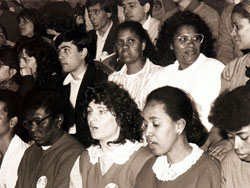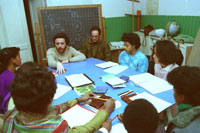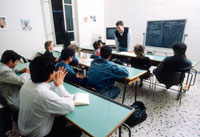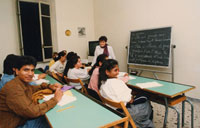
|
||||||||||
|
|
||||||||||
|
||||||
|
||||||
|
SANT'EGIDIO SCHOOL OF LANGUAGE AND CULTURE
Why Sant’Egidio opened a School of language After the racist murder of a Somali man in Rome, in 1979, the Community of Sant’Egidio started to help immigrants in Italy, as a response to hatred and intolerance. It was just the beginning of the migrations to Europe, but it was immediately clear the need of a strong commitment for integration, not only to react to racism, but also to get the best from the presence of “new Europeans” in our countries. This is why, in 1982, the Community founded its first School of Italian Language, totally free of charge and open to all. The very first students were Somalis, Ethiopians, Cape Verdeans, soon joined by people from Eastern Europe, Latin America and other African countries. In a short time, the school became a welcoming place for people from all over the world. Language as a Key for integration Besides the language, in the Sant’Egidio’s schools the students learn the culture of the country they live in: history, traditions, food habits, music and so on. All this helps the integration process, which is the main goal of the community work with immigrants. If you visit a Sant’Egidio’s School of Language you’ll see a plural, joyful and laborious place in which each one is warmly welcomed. 
The need to know Italian language (such as nederlands or spanish) and culture grows at the same time as the expectation of stable inclusion, and the interest and quality of the demand addressed to the school change. In the early years, for hundreds of foreigners, it was necessary to learn well and quickly the ''Italian of everyday life", i.e. the language to understand and communicate and to overcome the initial disorientation and isolation.
Over the years a different issue has also grown, expressed by immigrants that have lived in Italy for at least four or five years, who mainly come from Eastern Europe and Latin America and to a much lesser extent from Africa and Asia. They are mostly women, employed in domestic work and the care for people, many of them with a good level of schooling, several graduates, and with a few years of work experience in their own country, who initially emigrated alone and send home most of the money they earn to keep the whole family back at home. For them, the language school becomes the place of knowledge of Italian and European history and culture and, at the same time, the condition in which one experiences the possibility and opportunities for meeting and living together with people of a different language, culture and religion. A place where, as adults, they also delve into the history and memory of Italy and Europe. 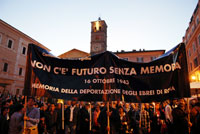
For Europeans, for the many immigrants from Ukraine, Romania or Poland, attendance to the courses has provided an opportunity to deepen knowledge of a history not always known in depth, sometimes confused in the more general memory of the world conflict, other times removed from memory as an event that is too painful. For example, an important training moment for all was the memory of the Shoah, which was also an occasion to reflect on the dangers of the present, on the risk of anti-Semitism and racism, accompanied by the participation in moments of common memory, such as the demostration on the occasion of the anniversary of the deportation of 16 October 1943 - which takes place every year and has become the memory of the city and the nation. An agreement between the School of Language and Culture of the Community of Sant'Egidio and the University for Foreigners of Perugia, gives the students the chance to get diplomas that are recognized at European level. |
ALSO READ
|
|||||

